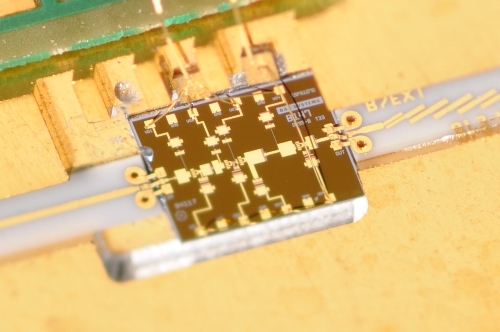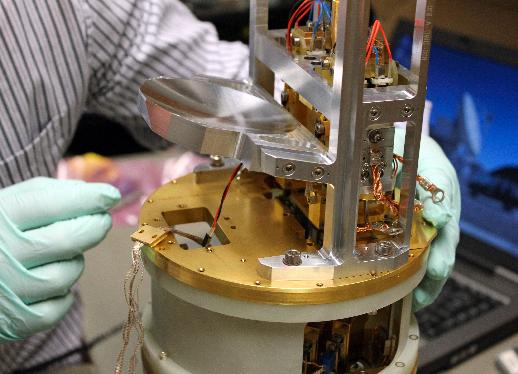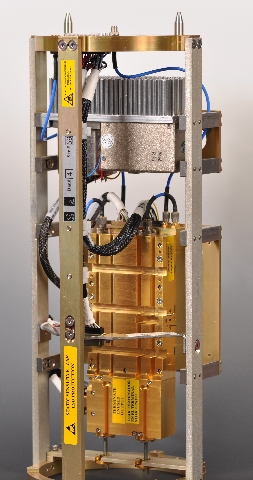June 5, 2012
Contact:
John Stoke
(434) 244-6896
jstoke@nrao.edu
Announcement: ALMA Telescope Upgrade to Power New Science
Before its construction is even completed, the new ALMA telescope is embarking on an upgrade that will help astronomers investigate the earliest galaxies and search for water in other planetary systems. The oversight board for ALMA, the Atacama Large Millimeter/submillimeter Array, has authorized the design and building of receivers that will enable the telescope to access a portion of the spectrum of light that it cannot currently study.
Over the next five years, each of ALMA's 66 dish antennas, located in the high-altitude desert of Northern Chile, will be outfitted with one of the new "Band 5" receivers.
The project will be undertaken jointly by two of ALMA's regional partners. The European Southern Observatory (ESO) will oversee development of the cryogenically cooled receivers, which will be fabricated by a consortium led by the Netherlands Research School for Astronomy (NOVA). In North America, the National Radio Astronomy Observatory (NRAO) will build the high-precision oscillators that will tune the receivers, so that the output from all antennas can be precisely combined to make high-resolution images.
The new receivers will be sensitive to light between wavelengths of about 1.4 and 1.8 millimeters, one of the ranges of the spectrum to which Earth's atmosphere is partially transparent, allowing the light to reach the ALMA antennas. These wavelengths correspond to radio frequencies between 163 and 211 GigaHertz.
"ALMA Band 5 will be an exciting advancement because it will let us study much of the light coming from some of the earliest galaxies in the universe," said Mark Lacy, of the North American ALMA Science Center at the NRAO. "Imaging that light will help us to understand when some of the first stars formed," he added.
The new receivers also will enhance astronomers' abilities to measure the presence of water -- a molecule essential to life -- in the dusty disks where planets are believed to form, and in the atmospheres of planets and comets in our own solar system. Water in space can be tricky to measure accurately, because of the confusing effects of observing through water vapor in Earth's atmosphere. The way in which ALMA's Band 5 receivers will measure water reduces some of these difficulties.
A total of 73 Band 5 oscillator cartridge assemblies will be built at the NRAO Technology Center in Charlottesville, Virginia, enough for all 66 antennas plus spares. They will be attached to the European receiver cartridges and the combined assemblies will be installed inside the ALMA antennas.
NRAO's development of the Band 5 oscillators draws upon the observatory's expertise and experience in this extremely high-precision technology; the oscillators for all seven receiver bands currently under construction for ALMA were built by NRAO. Band 5 will be the eighth receiver band for the ALMA telescopes, which are configured to eventually accept up to ten receiver bands. Future band development will further enhance ALMA's scientific capabilities.
ALMA, an international astronomy facility, is a partnership of Europe, North America and East Asia in cooperation with the Republic of Chile. ALMA construction and operations are led on behalf of Europe by ESO, on behalf of North America by the National Radio Astronomy Observatory (NRAO), and on behalf of East Asia by the National Astronomical Observatory of Japan (NAOJ). The Joint ALMA Observatory (JAO) provides the unified leadership and management of the construction, commissioning and operation of ALMA.
The National Radio Astronomy Observatory is a facility of the National Science Foundation, operated under cooperative agreement by Associated Universities, Inc.

ABOVE: Close-up of a crucial component of an ALMA Warm Cartridge Assembly, a custom power amplifier chip designed by NRAO engineers and fabricated by BAE Systems of Nashua, New Hampshire, using a process that enables such amplifiers to work at frequencies above the normal 100 GigaHertz limit of commercially available devices of this type.
CREDIT: NRAO/AUI/NSF
BELOW: One of the first six Band 5 receiver cartridges built for the Atacama Large Millimeter/submillimeter Array (ALMA).
The receivers were originally designed, developed, and prototyped by Onsala Space Observatory's Advanced Receiver Development group, based at Chalmers University of Technology in Gothenburg, Sweden, in collaboration with the Rutherford Appleton Laboratory, UK, and ESO, under the European Commission (EC) supported Framework Programme FP6 (ALMA Enhancement)
CREDIT: Onsala Space Observatory/Alexey Pavolotsky


